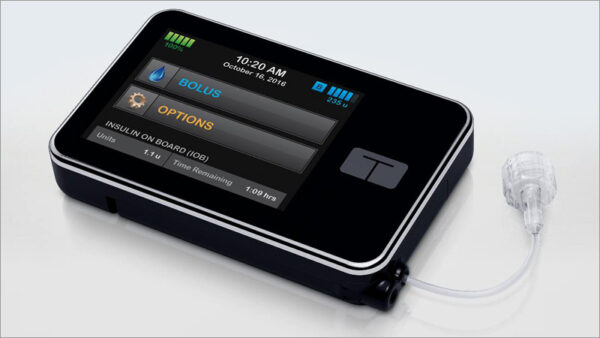
Positive clinical trial results for the Control-IQ algorithm from Tandem Diabetes Care presented at the American Diabetes Association meeting earlier this month positions the company to continue its growth trajectory into 2020 and beyond.
Two studies found that Tandem’s technology was able to drive 71 percent time-in-range and operate in active closed-loop mode an average of 92 percent of the time, results comparable to the market leading Medtronic 670G.
“It’s not just the time in range that matters, it’s the form factor of the pump, it’s ease-of-use and the CGM, along with how often is the algorithm actually on and enabled,” said Craig Hallum analyst Alex Nowak.
Tandem plans to submit the new product to the FDA in the coming weeks, with an expected launch by the fourth quarter of 2019.
The news is a major milestone on a remarkable turnaround for a company that seemed destined for bankruptcy just a few years ago.
Back in 2017, the San Diego-based maker of insulin pumps was in the pits. Its share price had dipped to record lows and many analysts dropped coverage in anticipation of Tandem’s failure.

A Deep-dive Into Specialty Pharma
A specialty drug is a class of prescription medications used to treat complex, chronic or rare medical conditions. Although this classification was originally intended to define the treatment of rare, also termed “orphan” diseases, affecting fewer than 200,000 people in the US, more recently, specialty drugs have emerged as the cornerstone of treatment for chronic and complex diseases such as cancer, autoimmune conditions, diabetes, hepatitis C, and HIV/AIDS.
This decline was driven by competitor devices taking big steps up in technical capabilities and a decision by UnitedHealthcare to make Medtronic the insurer’s exclusive in-network supplier of insulin pumps, shutting out other companies from a large portion of the market.
Just a few months away from default, Tandem was able to perform a financing maneuver that was eventually able to raise $69 million, keeping the company alive as it ramped up sales of its new t:slim X2 Insulin Pump.
“That was a real positive for us that took away the major selling point our competitors had, which was that we wouldn’t be around in two years,” Tandem CEO John Sheridan said.
The renewal cycle of many insulin pump patients and the exit of Animus and Roche from the diabetes market conspired to create an opportunity for Tandem to thrive, Nowak said.
While the company’s t:slim X2 Insulin Pump initially started shipping in 2017, Tandem has been progressively boosting its flagship product with technological upgrades.
Last year, the FDA approved the t:slim X2 Insulin Pump with its Basal-IQ technology integrated with the Dexcom’s G6 Continuous Glucose Monitoring system. The device has the ability to predict low-glucose events and automatically suspend delivery of insulin to avoid hypoglycemia.
“With this device we’ve heard people say they’ve had their first good night of sleep in years because it works and prevents nocturnal hypoglycemia,” Sheridan said.
Nowak pointed to the device’s status as the smallest pump on the market, as well as its touchscreen and sleek form factor as helping to drive sales growth. The company shipped 14,700 pumps in the first quarter of 2019, a 232 percent year-over-year increase.
“Anything you can do from a product and technology standpoint to make it easier for people with diabetes to use will ultimately lead to more purchases,” Nowak said.
The decision for Animus to exit the diabetes space has also given Tandem inroads to international markets. The company is currently distributing its products in 13 countries and is working with distributors to convert Animus users to Tandem.
In February, Tandem’s t:Slim X2 device received the first FDA designation as an alternate controller enabled infusion pump, which means that it can be used with different components that make up diabetes therapy systems.
Competitors are following on. Somewhat surprisingly, Medtronic recently announced plans to work with Tidepool on an interoperable automated insulin pump system.
Long-term, this designation is important in helping diabetes patients personalize their diabetes management strategies and improve patient safety, a major FDA priority.
In the short term, however, the decision clears the way for a faster regulatory and product development cycle for Tandem. Instead of the more burdensome PMA or de novo pathway, Tandem is able to use a 510(k) pathway for future products like its t:sport pump.
The t:sport is a modified wearable version of the company’s flagship pump, coming in at roughly half the size of the t:slim X2 and offering upgraded technology like wireless charging.
“The t:sport will be able to use the Control-IQ algorithm and there will be no additional significant regulatory or clinical studies required so that pulled our schedule up from mid-2021 into the second half of 2020,” Sheridan said.
Even with these positive indications, there’s still the issue of UnitedHealthcare’s exclusive relationship with Medtronic. Sheridan said the company’s stabilized financial situation, new clinical data and growing sales figures have changed conversations with payers dramatically.
“I think that there’s definitely openness to considering increased reimbursement because of our interoperability and the update ability of our pump,” Sheridan said. “We definitely intend to go back to UHC now and open the dialogue again and I honestly believe that it’s not a matter of if it’ll happen it’s just a matter of when.”
Tremendous opportunity exists with the continued growth of the insulin pump market. Only around 30 percent of the diabetic patient population uses insulin pumps, leaving thousands of patients largely controlling their diabetes through manual daily injections. Sheridan said around half of their new customers come from this group and half from patients switching their pump device.
“We believe that by focusing on simple, intuitive and easy-to-use devices that reduce the burden of diabetes and at the same time improve outcomes we really believe that we can change the market penetration rate from 30 percent today to 50 percent,” Sheridan said.
Photo: Tandem Diabetes Care













